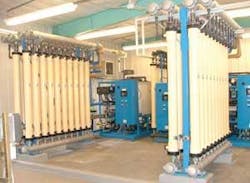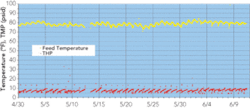By Joe Habib and Richard Reightmyer
In 2002, the Hobart Wastewater Treatment Plant selected hollow fiber microfiltration (MF) as the primary component of a tertiary treatment upgrade. The upgrade was required to ensure compliance with New York City Department of Environmental Protection (DEP) watershed regulations. The 180,000 gpd wastewater treatment plant (WWTP) serves approximately 255 residential units, a juvenile detention center and a pharmaceutical operation.
The publicly owned WWTP is located within the watershed for New York City’s water supply, some 120 miles north of NYC in the Catskill Mountain region. The plant discharges effluent directly into the West Branch Delaware River, which feeds the Cannonsville Reservoir, one of six NYC reservoirs in the watershed.
The Village of Hobart was required by DEP to treat its secondary effluent to meet State Pollution Discharge Elimination System (SPDES) permit limits. DEP subsequently funded the tertiary treatment system upgrade which included the addition of coagulation/flocculation, multi-media filtration, hollow fiber microfiltration (MF), and low-pressure ultra-violet disinfection.
NYC Water and Filtration Avoidance
New York City has the largest unfiltered surface water supply in the world providing 1.3 billion gallons of water per day to eight million city residents. The watershed spreads across eight counties as far as 125 miles north of the city. The city’s supply system operates under a conditional Filtration Avoidance Determination (FAD) which is based on the exceptionally high quality of water in the reservoirs. The city has maintained its FAD by taking measures that ensure protection of the watershed. Upgrading wastewater treatment facilities in the watershed has been a key component in this continued effort. Since the Village of Hobart lies within the watershed, it is subject to NYC Watershed Regulations. It is also one of many publicly owned systems that have benefited from a NYC-funded upgrade.
Hobart WWTP
Constructed in 1975 with an initial a capacity of 80,000 gpd, Hobart’s WWTP first underwent a major upgrade in 1993 which increased capacity to 180,000 gpd. The process following the 1993 upgrade included primary treatment consisting bar screening, a grit chamber, and diurnal equalization. Secondary treatment included parallel extended aeration activated sludge reactors followed by secondary clarifiers. Final disinfection was provided by chlorine contactors. While this configuration generally worked well, subsequent revisions to the NYC Watershed Regulations required the addition of tertiary treatment to provide further reduction in phosphorous, suspended solids, fecal coliforms, Giardia, and enteric viruses.
Membrane System Specifications
Microfiltration was selected as the basis for the tertiary upgrade. Specifications required by NYC for the selected microfiltration system included:
- A maximum flux of 23.3 gfd
- Full system redundancy with either system capable of treating peak flow with the other unit out of service.
- Coagulation and sand filtration required as pre-treatment to the Microfilters.
Tertiary Treatment Upgrade
The plant was subsequently upgraded with a complete tertiary process designed around a Pall Aria™ Microfiltration System. The tertiary system went online in 2002. Effluent from the secondary clarifiers now undergoes coagulation, rapid mix, and flocculation. Media filtration follows and filtrate is sent to a clearwell which feeds the microfiltration system. Microfiltration effluent is then treated by UV for final disinfection.
Backwash discharge from the sand filters and the primary membrane system is directed to a mudwell. The mudwell feeds a third membrane rack for backwash recovery. Filtrate flow from the two primary membrane systems and the backwash recovery unit are blended prior to the UV contactors. Backwash discharge from the recovery unit is sent to a sludge holding tank for further processing. Decant from the sludge tank then flows to the front end of the tertiary system and sludge is sent to a plate and frame press for dewatering.
Microfiltration System
The primary membrane system consists of two racks totaling 40 hollow fiber modules. The backwash recovery unit contains an additional seven modules. Both primary and recovery racks use the same polyvinylidene fluoride (PVDF) membranes rated at 0.1 mm. Each six-inch-diameter module contains a fiber bundle made up of several thousand individual 1.3 mm diameter fibers for an effective filter area of 538 square feet (based on the outside diameter of the fiber). The system is designed per NYC Rules and Regulation, and rated accordingly at the plant’s capacity of 180,000 gallons per day.
Automatic controls operate the microfilters through the cycle of filtration, air scrub, and backwash and collect turbidity, flow, and pressure data that can be used to monitor performance. Remote monitoring capabilities allow plant operators or the manufacturer’s engineers to access, monitor, and control the plant via a modem connection.
In addition to hydraulic backwashing, the system has the capability to use an integrated enhanced flux maintenance (EFM) process to supplement the backwash regime with a chemically assisted process. EFM typically uses sodium hypochlorite at 300–500 mg/l circulated through the membrane rack and can be used on a daily basis to help control fouling. Although equipped, the EFM capability is rarely employed during normal operation due to the very low fouling potential of the sand filter effluent which feeds the MF.
Typically, if the membrane transmembrane pressure approaches a terminal limit (up to 40 psi) due to fouling, membranes undergo a full clean-in-place (CIP) procedure using a sodium hydroxide/sodium hypochlorite solution followed by a citric acid solution. While fouling is not an issue with Hobart’s MF plant, periodic CIPs are still performed every few months per manufacturer’s recommendation.
Conservative Membrane Design
Membrane systems designed per NYC watershed Rules and Regulations adhere to conservative specifications. While membranes are capable of running directly on secondary effluent, the requirements for prefiltration, redundancy, and low design flux ensure robustness and reliability. While the MF system can handle design flow with either of the two skids offline, it is common practice to place all available membranes online including redundant capacity during routine operation.
During the highest recorded monthly flow following the installation of the membrane system, hydraulic loading peaked at 254,000 gpd, exceeding the plant’s rated capacity by 36% in March 2007. During this peak flow event, membrane flux and transmembrane pressure remained below 13 gfd, and 13 psi respectively, well below the membrane’s capability. During normal plant flow (55,000–65,000 gpd), the MF system typically runs at a very conservative 5 gfd or less with corresponding TMP typically less than 5 psi.
SPDES Compliance
Prior to tertiary treatment, the Hobart plant was occasionally out of compliance with SPDES permit limits for phosphorous (P), suspended solids (SS), and fecal coliforms. Since the upgrade in 2002, discharges have remained well within permit limits. Additionally, turbidity from the MF plant is consistently in the 0.05–0.07 NTU range based on archived online data. This is well within the SPDES specification of less than 0.5 NTU. Sampling of Giardia and enteric viruses are performed quarterly by DEP, and there have been no non-compliance issues to date.
Fecal coliforms in the plant effluent are also consistently below detection limits. A supplementary analysis for fecal coliforms was performed on composite samples taken at various stages of the overall treatment process in October 2007. The results of this testing determined that removal of coliforms from the sand filter may not be complete, and that only after passing through the membranes are coliforms below detection limits.
Conclusions
- Hobart has continually met SPDES requirements since the membrane upgrade.
- Conservative membrane design has resulted in a robust system that exhibits little fouling even under extreme conditions.
- Lab analyses indicate that coliforms can pass through the sand filters, but are removed by the membranes.
- The MF system has been reliable and easy to maintain after nearly six years online.
About the Author:
- Joe Habib is a Senior Project Manager for Long Island-based Pall Corporation. Throughout his 10 year tenure with Pall, Habib has managed and conducted pilot studies in membrane filtration for municipal and industrial water treatment applications. He holds a BS in Engineering Science from the City University of New York, in addition to an MS in Environmental Science from Long Island University. He also currently serves on the New York Water Environment Met Chapter Environmental Science Committee.
- Contributors to this article included Richard Reightmyer, LVDV Operations, Inc., Lamont Engineers, O’Brien & Gere, Consulting Engineers





